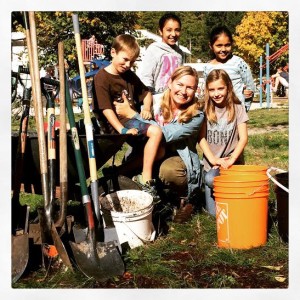By Rhonda O’grady
Published: July 10, 2016
Published: July 10, 2016
THERE is an urgent need for educating our students and communities about the importance of our native pollinators. With the collapse of honey bee colonies around the world, our wild bees and other native pollinators such as, butterflies, hummingbirds and beetles have become vital to the survival of our food crops and ecosystems. (Honey bees are not native to North America.) 
Unfortunately, our wild pollinator populations are also in decline. The greatest concern, as it is for most species on the planet, is habitat loss. Pesticides, intensive agriculture and global warming also threaten their survival.
Saving pollinators and their habitats is not a selfless act however – it’s about saving our own necks.
We need pollinators. They are responsible for bringing us one out of every three bites of food. They also support our ecosystems and produce our natural resources by helping flowering plants reproduce.
And if that doesn’t cause alarm, losing pollinators means saying goodbye to chocolate and coffee.
The creation or restoration of habitat for bees and other pollinators is a solid beginning to securing the future of our food and our morning coffee. Helping our local pollinators is something we can all do. It’s easy, educational and loads of fun, and there’s a bonus: by attracting pollinators to your garden you’ll triple the yield and increase the size of your fruits and veggies.
The Squamish River Watershed Society with funding from the Community Foundation of Whistler has designed a “Community Pollinator Habitat Kit”– an educational resource to help support you, our schools and our communities in restoring or enhancing pollinator habitats.
You will find The Squamish River Watershed Society’s “Community Pollinator Habitat Kit” a hive buzzing with information and resources to help you get started on your habitat restoration project. Your project can be as small as a few pots filled with native flowers or as big as a wildflower meadow with mason bee houses, hotels and beyond. All are needed. All will make a difference.
As our natural world is lost beneath the concrete of “progress,” our private yards, schools, churches and community centre properties can and will play an important role in the future of wildlife habitat and corridors.
At Valleycliffe Elementary School, students have been restoring a meadow they call “The Living Classroom” into prime pollinator habitat by planting native flowers and vegetable gardens as well as building mason bee houses and a “Grand Hotel” for bees and other beneficial insects. This place-based, experiential learning project helps the students discover first-hand the relationship between our pollinators and our food and the health of our ecosystems. It also gets the kids out of the classrooms and into their true natural habitat – nature. Un-bee-lievable!
“The Community Pollinator Habitat Kit” includes: pollinator garden resources, local native plant lists, pollinator and plant identification guides, guides for how to build mason bee houses and pollinator hotels. In addition, you will find an inspiring Imax pollinator video – Wings of Life,pollinator and pollination themed books, activities and games, pollinator models, links to supportive information and so much more…
The Squamish River Watershed Society, hopes this kit will inspire its users to get outside with their children or students, create some fun outdoor memories, motivate communities to work together and maybe, amid all the learning and laughter, help save the world.
As the credited “father of biodiversity,” E.O. Wilson wisely stated: “It’s the little things that run the world.”
The kits are now available for loan at the Squamish, Whistler and Pemberton libraries.



